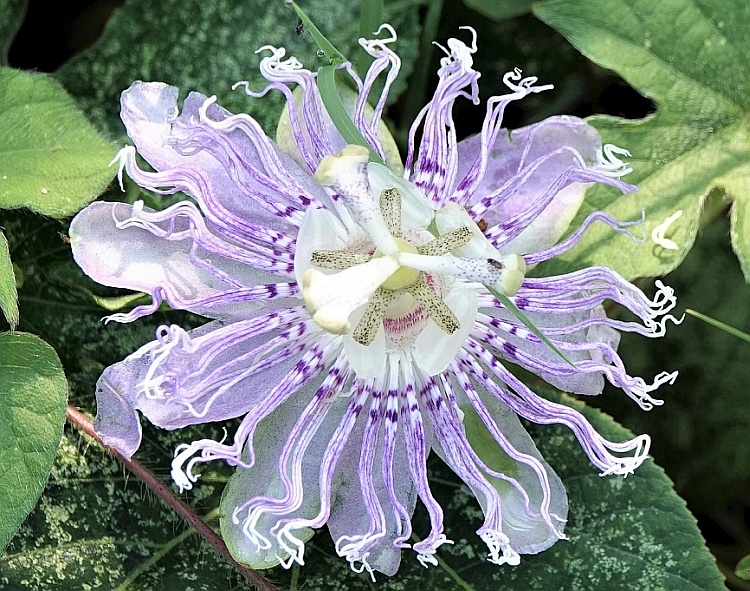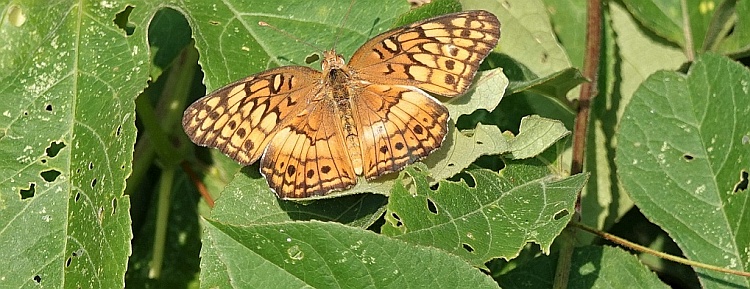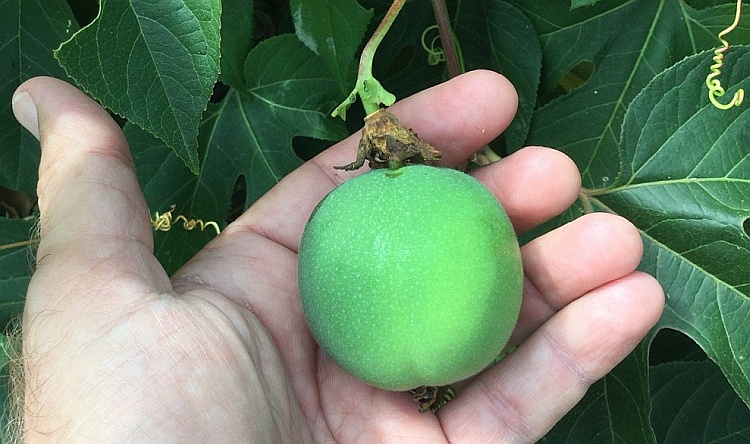Purple Passionflower Pops in Summer
By Betsy Washington, Northern Neck Chapter
Driving along sandy roadsides and fields of the coastal plain in summer, it is always a delight to find our native Purple Passionflower (Passiflora incarnata), a deciduous vine with dark green, three-lobed leaves and exquisite, showy flowers and edible fruit. This vigorous vine is native to the southeastern United States from Kansas to Pennsylvania and southward to Florida and Texas. In Virginia, it is most common in the southeastern coastal plain and outer Piedmont. Occurring in both Lancaster and Northumberland counties, it is one of the hardiest Passionflower species. It is quite drought tolerant once established and adaptable to a variety of soils, but prefers sandy or loamy soils and sunny sites. It is found along roadsides and other open disturbed sites, and in meadows, fields, and thickets, as well as in low moist woods and along stream banks.

Purple Passionflower has exquisitely beautiful, fragrant flowers over a long period in summer. Photo by Betsy Washington
The exquisitely beautiful flowers belie the rugged nature and exuberance of this vine, which grows quickly and often spreads by root suckers. The fragrant flowers bloom over several months from late May to August and are real show-stoppers. They are about 3” in diameter with an intricate fringed central crown of wavy bluish-purple filaments banded with darker purple that radiate out above ten pale bluish-white petals and sepals, like a pinwheel. Above the crown dramatically large pistils and stamens are themselves showy and speckled with purple. Words really can’t describe the beauty of these flowers! In this case a picture really is worth a thousand words… A succession of blooms dazzles for several months although each individual flower lasts only a day or two.
The flowers are followed by fleshy, egg-shaped fruit that ripen from July to October turning from green to yellow. They are delicious eaten right off the vine but also make wonderful jellies, jams, and desserts. Most folks cut the fruit in half and scoop out the inside while skipping the skin – the taste has been described as appealing, musky, or guava-like. The crunchy seeds in the fruit are edible if you are so inclined. The showy flowers themselves are edible and make a beautiful garnish. The hollow fruit make a loud “popping” sound when stepped on, giving rise to another common name, Maypop, although some believe the name comes from the new shoots that “pop” out of the ground in spring in May.
A large variety of pollinators, especially bumblebees, carpenter bees, and butterflies, literally hover over the fragrant blooms. Ruby-throated hummingbirds are also attracted to the nectar. Purple Passionflower is the host plant for several of our showy butterflies, including the Variegated Fritillary, Gulf Fritillary (an uncommon visitor in our area), and Banded and Red-banded Hairstreaks. Numerous songbirds and small mammals relish the fruit as well as humans. Native Americans made a poultice from the roots to treat cuts, bruises, earaches and inflammations, and a tea and tonic were cooked from the roots to ‘sooth the nerves’ and treat insomnia. Although modern medicine hasn’t verified all of this, Purple Passionflower is still a popular herbal resource.

Purple Passionflower is the host plant for the beautiful Variegated Fritillary shown here. Photo by Betsy Washington
This beautiful, vigorous vine climbs by tendrils and is best grown on large trellises, arbors, pergolas or along fences or walls, but it will also happily scramble over the ground covering a large area as it suckers from its roots. It can make a great ground cover or bank stabilizer with the vines tumbling down a slope and spreading by root suckers to anchor a large area. Of course the added bonus are its long lasting blooms alive with pollinators and edible fruits.


I have looked for this locally (Northumberland County) with no luck.
Hi Pamela, I saw them growing at Powhatan State Park today along a path called Turkey Trail. The path was in full sun with no trees nearby. Good luck with your quest.
I am here because we’ve found these blooming on property my daughter just bought in Halifax Co. I’m still wondering… “What wildlife will eat the fruit before I’m ready to harvest it?”
The Digital Atlas of the Virginia Flora shows the Passionflower as native in Northumberland county (http://vaplantatlas.org/index.php?do=plant&plant=3111). However, it may be difficult to find. The Digital Atlas says habitat includes “fencerows, roadsides, old fields, forest borders, and other open, disturbed habitats.”
I used to grow these at a townhouse in Alexandria where I used to live. Would love to introduce them here as well. Anyone know where to purchase maypop plants?
I saw a whole field of them, where are you located? I can dig one up or root some, they’ll probably ship fine if you are still in VA, I am in NoVa, but the field I saw them in is on the Chesapeake bay near Glouster.
I’d LOVE to get some for my yard and to fight with some of the non-native invasives on a border. I’m in Ashburn area (NOVA). So, I’d be happy to drive over myself.
I live in Arlington and have this growing in my yard. It is very hardy and the bees love it. Let me know if you’d like some.
I also want to suggest going back to that town house you lived in and asking the owners if you can take some cuttings, they will root for you in no time!!!
Great Big Greenhouse in Richmond carries them.
I would love to know where your townhouse was in Alx; the city or the county? I’d be willing to seek out the address and request a cutting.
NO, THEY ARE A VERY VIGOROUS GROWING VINE. IN MID SUMMER THE VINE GROWS UP TO 6 INCHES A DAY.
I found and dug up 2 plants. Can you trim to make like a bush?
Can these be grown in a container?
Yes, I was able to get fruit, let it dry out, extracted the seeds, and had success with about 50% germinating, but only one matured enough to flower. I started in summer directly outdoors instead of spring.
I found a large plant with many flowers and fruits on the side of railroad tracks in the middle of downtown Richmond 🙂
Do you remember where this was exactly? I’ve found maypops around Richmond but none yet with any fruit!
Located in NOVA. George Mason University grows them in their food. 8 was able to take fruit home years ago and had successful seedlings. Have also seen them along the W&OD in Reston area. Like all vines rather invasive if you don’t train and prune. Enjoy!
Would love to get my hands on one. I live in Danville. Any ideas?
I have been growing these for a couple years now. So far all of the fruit has been hollow. They are getting plenty of water. Why would the fruit be hollow?
I first discovered Passion Flower on Nettles Drive by the railroad tracks (among delicious blackberries) in Newport News, which is southeastern Va. After 3 tries, I was finally able to transplant a rooted plant to my Dad’s house on the Warwick River. Bumblebees take naps on the flowers! We still haven’t figured out the best time to harvest the fruits, or maybe we just don’t like them. And how do you juice the fruit?? That’s what we really want from the fruit; we don’t want to eat it.
I’m a bit late to the party, but Merrifield Garden Center (several locations in Fairfax, Va) has a few left, with fruit and flowers on them. They appear to carry them fairly regularly and are more usually available in spring or summer. Naturally, I just bought one (late to the party) and will attempt not to kill it.